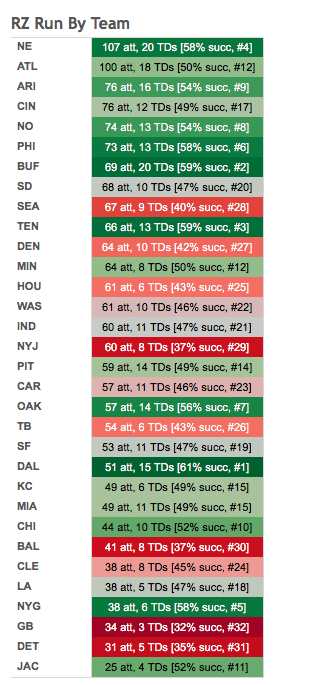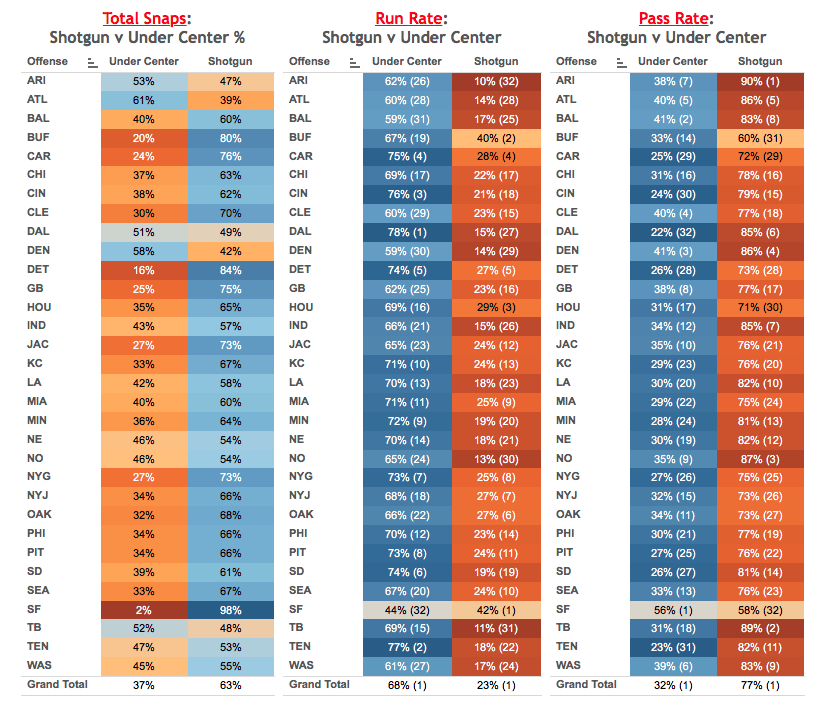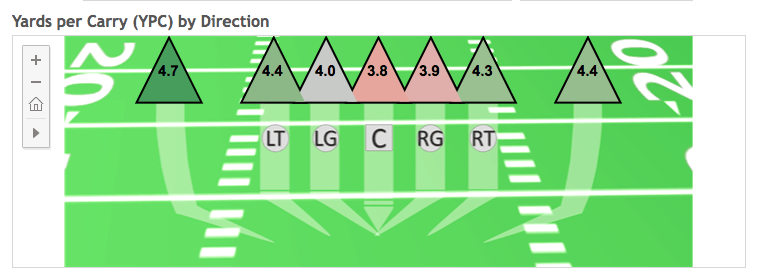In evaluating situational rushing performance from various formations, it is apparent that not all NFL backs are as good running from spread and shotgun formations. The most popular formation is “11 personnel” which is used by NFL teams on 60% of offensive snaps. No other formation is even used 20% of the time. [11 personnel is 1 running back, 1 tight end and 3 wide receivers.] Of the over 20,000 offensive plays from 11 personnel, teams lined up in shotgun on 81% of these snaps. When they were in shotgun from 11, they passed the ball 76% of the time. When they were under center from 11, they ran the ball 65% of the time.
The shotgun formation is becoming ever more popular in the NFL with the league wide average usage at 63.5% last season. We have heard the narrative of guys like DeMarco Murray struggling when asked to run out of spread shotgun formations, and there are pure football reasons for this beyond just the statistics. Running from the shotgun takes a slightly different skill set than the I-formation sets many runners are accustomed to employing.
Patience is a key trait to see the hole in an outside or inside zone and make their move. Running backs also need to have that acceleration to burst through the hole once it is seen. While these may seem like key traits to any running back, they are even more important to spread rushers as they typically try to attack the edges of defenses and get their backs out in space.
Last year, the average NFL team ran 187 plays to what is deemed the outside (tackles and out) and 214 plays to what is deemed the inside (guards and in). On inside runs, the league-wide average was 4.01 yards per carry. Outside runs were much more effective averaging 4.74 yards per carry. With ends and outside linebackers getting lighter and lighter by the season, this is something offensive coordinators can exploit with spread runners. Chip Kelly, for all the flack he got at the NFL level was one of the best at attacking the edges in the run game and letting his runners barrel through smaller defenders or take it to the outside and use their speed. Last season the top five rushing attacks belonged to the Buffalo Bills, Dallas Cowboys, Tennessee Titans, San Francisco 49ers, and Atlanta Falcons. Here is how those teams ranked in yards per attempt to the outside: Buffalo (5th), Dallas (11th), Tennessee (4th), San Francisco (6th), and Atlanta (9th). Attacking the edge is an increasingly important factor in today’s NFL, and teams that do it best usually have successful run games.
Last season, NFL teams ranged from 50 (Cardinals) carries to 444 (49ers) carries out of the shotgun formation. From under center, San Francisco had just 15 carries while the Atlanta led the Falcons with 423 carries. The average NFL team last year attempted nearly 100 less rushes out of the shotgun formation despite the league being more effective as a whole out of the set. The average NFL team averaged 4.82 yards out of shotgun formation last season and a lowly 3.63 out of under center, that’s a difference of nearly 1.2 yards per attempt! One reason to believe teams are so much more effective running out of the shotgun is because of run pass splits. When we examine the shotgun split league-wide we see that NFL teams run out of the shotgun formation just 23.5% of the time and throw it 76.5% of the time when they are lined up deep. Conversely, in under center formations teams run the ball 68.3% of the time and throw it on just 31.7% of plays. NFL teams know this split, giving the benefit of the doubt to the runner and opening up wide lanes for them to crash through.
Lets also take a look at play calling splits from under center and in shotgun when in the opponent’s redzone. This is particularly valuable for end efficiency, which includes fantasy touchdowns, as most rushing TDs originate from red zone runs.

The shotgun is used slightly less frequently here at just 61% of the time. When in shotgun teams still throw the ball on 75% of plays. Under center, teams run the ball more often on 75% of plays. Using the shotgun run could be just as effective in the redzone as it is in the open field with defenses knowing these tendencies. Spreading the field and running from the shotgun set can be a key edge for any team, especially one with a heady quarterback who can run RPO’s (run pass options). Looking at the careers of the top-40 fantasy running backs last season there is a remains a stark contract between effectiveness between running out of the shotgun (4.68 yards per carry) and from under center (4.17 yards per carry). The top-40 running backs last season have season 28.6% of their career carries from shotgun formation. Now that we have set the stage league wide, lets examine some players who over the course of their careers (to increase sample size) have shined and struggled while running out of shotgun formations:
Effective Shotgun Runners
LeSean McCoy has the most attempts of any runner in my database out of shotgun sets, checking in at just fewer than 1,000 carries out of the set with 992. Even Jamaal Charles and Adrian Peterson have just 312 and 130 carries from the shotgun in their respective careers. In fact, he has twice as many carries as the next guy Matt Forte out of shotgun. In his career, 52.4% of McCoy’s carries have come from the shotgun. In shotgun, McCoy has averaged 4.9 yards per attempt, 0.3 over his average from under center. His 23 touchdowns are ten more than the second highest running back in Lamar Miller. While McCoy is effective running from under center, putting him back in the shotgun will give defenses nightmares.
Jordan Howard was dynamite when in the shotgun set last season, blowing away all other runners busting off runs at a 7.0-yard clip. While Jordan Howard’s sample size may look small, with 94 carries from shotgun last season, Mark Ingram has just 96 and he has been in the league since 2011. The entire top-40 from last year’s career average is just 185 carries, so while smaller than we would like it was still a big season. Howard gained 657 yards on his 94 carries but did not score a touchdown. Howard averaged a solid 4.2 yards per carry last season, but his 2.8 yards per carry difference between splits was the largest measured in this sample.
Carlos Hyde was run almost exclusively out of the shotgun last season under Chip Kelly, much to his delight. 213 of his 217 carries last season came from shotgun and he thrived to the tune of 4.6 yards per carry. He has been even better than that in his career averaging 4.8 yards per carry on 297 attempts. Ten of Hyde’s 13 rushing touchdowns have also come out of shotgun. Issue is, under center Carlos has struggled to the tune of just 3.1 yards per carry on 118 attempts. Projecting forward, this could be the scheme fit issue John Lynch and Kyle Shanahan have spoken about this offseason. As previously mentioned, Atlanta, Shanahan’s former squad, ranked first in under center rushes and the 4th lowest in shotgun rush attempts, maybe all that talk about a surprise cut isn’t too far out of whack.
Ty Montgomery has the look of a prototypical spread runner, with requisite bulk and acceleration to attack the edges of a defense. Montgomery’s pass catching ability is already up there with the top running backs in the league, and working out like a running back will help him in his first full-season at the position. Montgomery was a monster on shotgun runs last season, rushing for 347 yards on 53 carries, that’s a 6.5 yard per rush clip and also scored all three of his rushing touchdowns. From under center, the former wide receivers attempts were limited gaining 124 yards on 24 carries. This doesn’t even mention how good Ty is as a receiver out of the backfield, where he is sure to be a big factor this season.
Bilal Powell has been hyped this offseason as maybe taking over more of the rushing role, and if they implement it effectively, it could pay dividends for a team expected to struggle almost across the board on offense. In his career, Bilal has rushed for 1,333 yards on 258 carries, a 5.2 YPC clip. When under center, Powell has rushed 275 times for 990 yards, just 3.6 yards per rush clip. Powell’s ability to run from the shotgun could be important if the Jets choose to run a spread formation with either Josh McCown or their young inexperienced quarterbacks in Bryce Petty or Christian Hackenberg.
Other notables: Duke Johnson, James White, Rashad Jennings, and Jeremy Hill.
Less Effective Shotgun Runners
Ezekiel Elliott was a revelation for the Cowboys last season, but he wasn’t quite the runner out of shotgun as he was from under center. On 53 attempts out of shotgun, Zeke compiled 234 rushing yards and just two touchdowns. From under center, Zeke buttered the bread, racking up 1,396 yards on 269 carries and 13 touchdowns. This came as a surprise as Zeke came from a spread offense in college and had Dak Prescott’s rushing threat to keep defenses honest on the backside. In Dak’s second season in the league, Zeke could be lined up in shotgun more than you may expect, so he needs to improve in this area. In total, The Cowboys ran 541 plays out of the shotgun and 533 from under center. When under center the team had the highest run percentage in the league at 77.9%. In shotgun, they had the sixth lowest run rate at 20.7%. Some more variation in formations with an athletic quarterback at his side could make Zeke even more dangerous, but if not power football worked like a charm last season.
DeMarco Murray is always the name brought up when you talk about running from under center and out of shotgun, and while it might be slightly overblown, it has some merit. Under center, Murray has been excellent, with 1,081 career rushes for 5,037 yards and 32 touchdowns. Out of shotgun, Murray has just 339 career carries for 1,478 yards and 11 rushing scores. Half of Murray’s rushing attempts from shotgun came in his 2015 season in Philly and he averaged just 3.6 yards per attempt on them that year. On the other 173 career carries from the shotgun, Murray has compiled 884 yards or 5.11 yards a rush. So while Murray’s numbers don’t look great because of 2015, that may not be indicative of his true talent as a spread runner. Last season Murray averaged 5.4 yards per carry from the shotgun and 4.2 from under center. Murray continues to be an underrated performer at the running back position.
LeGarrette Blount does one thing and one thing well, run from under center; he does not provide a dynamic backfield threat however. In his career, just 8% of Blount’s runs have come from shotgun sets. On 97 career carries, Blount has rushed for 374 yards, just 3.9 a rush and scored three times. Under center, Blount is a beast, on 1,070 career carries he has rushed for 4.4 yards an attempt and scored 37 times. Blount’s new team the Eagles were in the shotgun 13% more than the Patriots and had nearly double the amount of their runs come from the shotgun formation. Besides obvious touchdown regression, maybe there are more reasons to be concerned about LB this season.
Tevin Coleman is a surprise show on the list, you’d think a player with his speed and acceleration would be great out of shotgun sets, and maybe he is, but he was never really given a chance to show that off with just 34 attempts to date from shotgun. On those carries he has gained just 94 yards and scored two touchdowns. New offensive coordinator Steve Sarkisian can either buck his trend for us, or prove that the team doesn’t see him in that light. In his NFL career, Tevin has 816 yards on 171 attempts from under center with seven rushing touchdowns. Tevin has major upside to his game, but will need to work on the nuances to bring it all together, and showcasing his skills from shotgun will be an even bigger part of his game.
Other notables: Adrian Peterson, Mike Gillislee, Mark Ingram, Theo Riddick, Jerick McKinnon, and Latavius Murray.
About the author: Anthony Staggs ( @PyroStag ) was crowned co-winner of the Sharp Football Stats 2017 Writing Contest. He will share articles featuring his analysis throughout the 2017 NFL

















